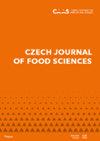Comparative Study of some Physicochemical Properties of Extracted Oil from Modified and Non-modified Cottonseeds
IF 1
4区 农林科学
Q4 FOOD SCIENCE & TECHNOLOGY
引用次数: 0
Abstract
Purpose: The objective of this study was to investigate the physicochemical characteristics of seeds oil extracted, roots and leafs from genetically modified cotton seeds and local non-genetically modified. Methodology: Cotton seeds samples were collected from Elguziera State farms and White Nile State farms, Sudan. Collected samples were transferred to the Central research laboratory of natural and environmental resources. Oil from cotton seeds was extracted using soxhlet method, hexan was used as solvent. Determined physicochemical characteristics were pH, refractive index, specific gravity, free fatty acids, acid value, peroxide value, iodine value, saponification value, and In addition the moisture, ash, protein, fat, fiber, calcium, Iron, magnesium, Potassium, and phosphor from roots and leafs. Findings: The two oil samples showed significantly (P≤0.05) difference in oil content, but they showed no significant difference in refractive index with a mean value of 1.47, also specific gravity; in all samples ,had value (0.94), showed significantly (P≤0.05) difference in peroxide values between Elguziera State farms and White Nile State farms; also significant (P≤0.05) difference in iodine value (7.61, 1.67, 2.18 and 1.167 respectively) was observed, saponification value (5.61,1.96, 1.96,and 4.77 respectively), free fatty acids (2.82,1.80,3.03 and 8.84 respectively), acid value (4.20,4.48,4.48 and 4.76, respectively) showed significant (P≤0.05) difference.改性与未改性棉籽油理化性质的比较研究
目的:研究转基因棉籽和本地非转基因棉籽提取的籽油、根和叶的理化特性。方法:棉籽样本采集自苏丹Elguziera国营农场和白尼罗河国营农场。采集的样品移送中央自然环境资源研究实验室。采用索氏法提取棉籽油,以己烷为溶剂。测定的理化特性包括pH值、折射率、比重、游离脂肪酸、酸值、过氧化值、碘值、皂化值,以及根和叶中的水分、灰分、蛋白质、脂肪、纤维、钙、铁、镁、钾和磷。结果:两种油样含油量差异有统计学意义(P≤0.05),折射率差异无统计学意义(平均值为1.47),比重差异无统计学意义(P≤0.05);在所有样品中,均有值(0.94),Elguziera国营农场与White Nile国营农场的过氧化值差异显著(P≤0.05);碘值(分别为7.61、1.67、2.18、1.167)、皂化值(分别为5.61、1.96、1.96、4.77)、游离脂肪酸值(分别为2.82、1.80、3.03、8.84)、酸值(分别为4.20、4.48、4.48、4.76)差异均显著(P≤0.05)。
本文章由计算机程序翻译,如有差异,请以英文原文为准。
求助全文
约1分钟内获得全文
求助全文
来源期刊

Czech Journal of Food Sciences
Food Science & Technology, Chemistry-食品科技
CiteScore
2.60
自引率
0.00%
发文量
48
审稿时长
7 months
期刊介绍:
Original research, critical review articles, and short communications dealing with food technology and processing (including food biochemistry, mikrobiology, analyse, engineering, nutrition and economy). Papers are published in English.
 求助内容:
求助内容: 应助结果提醒方式:
应助结果提醒方式:


